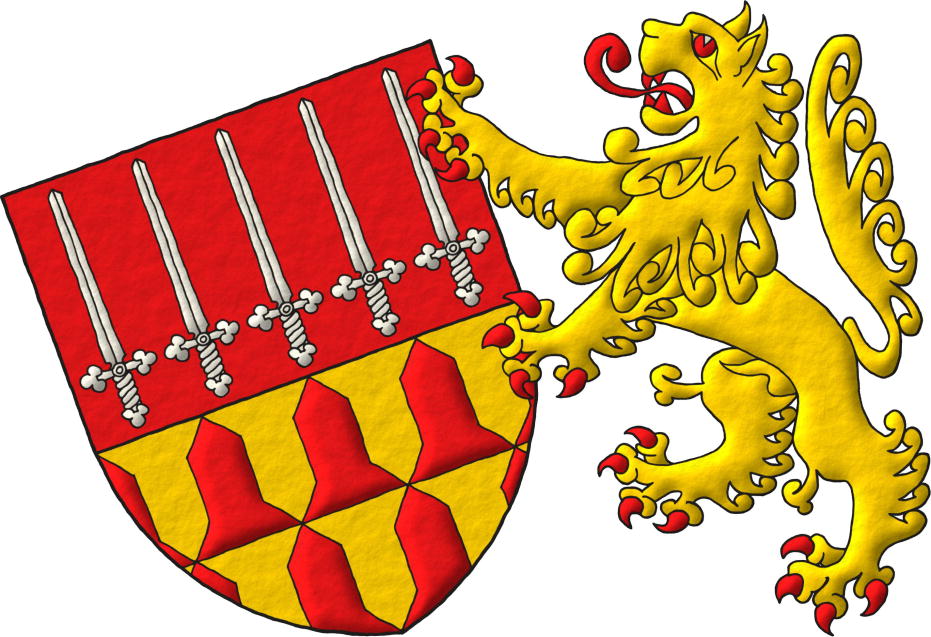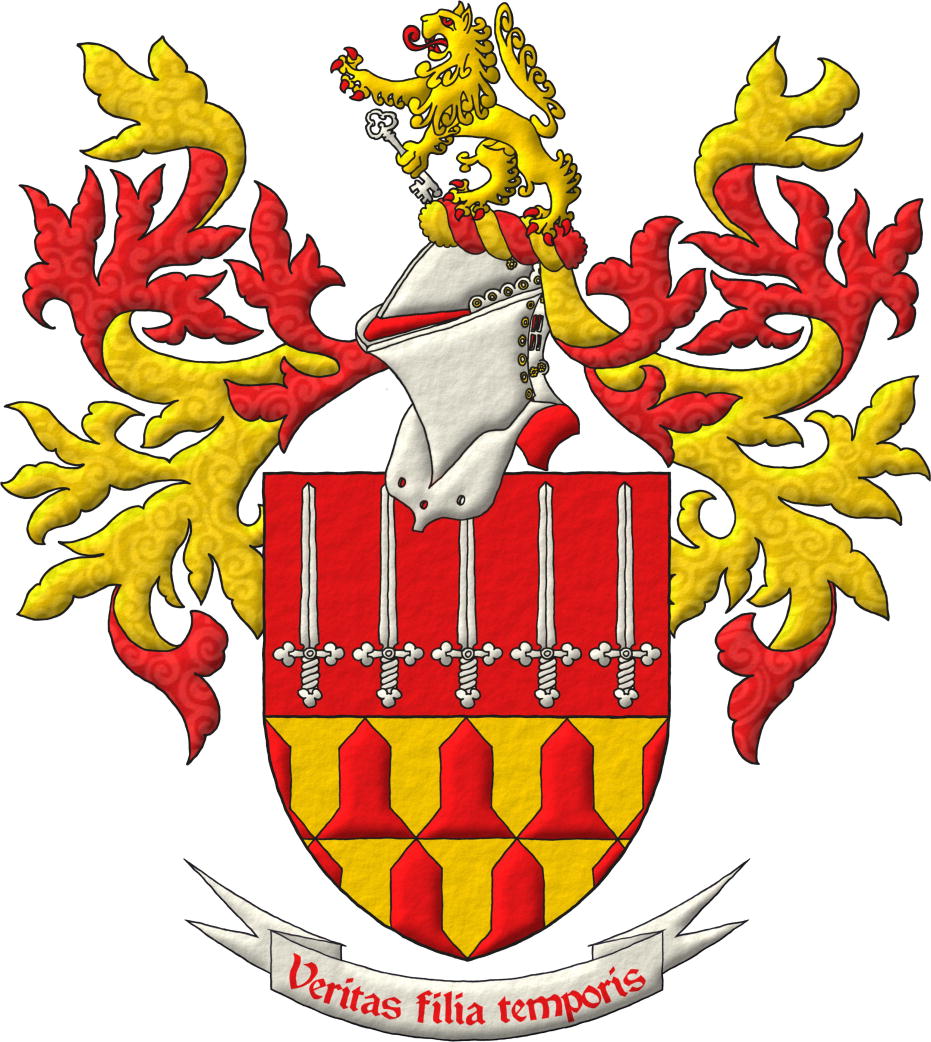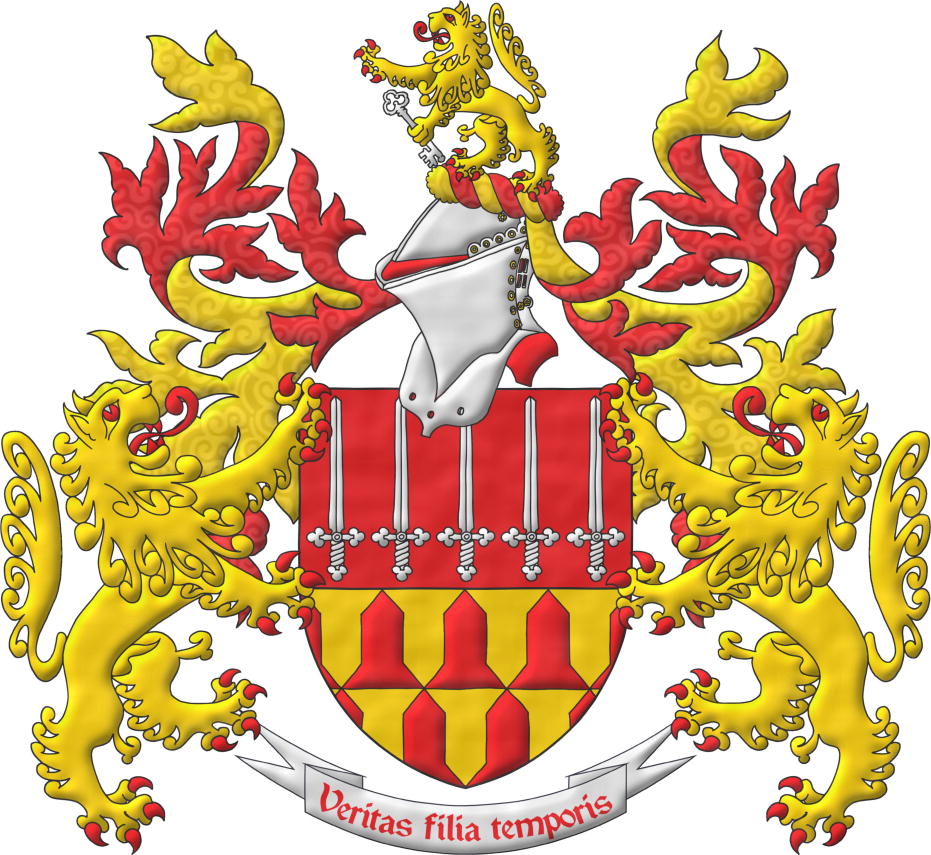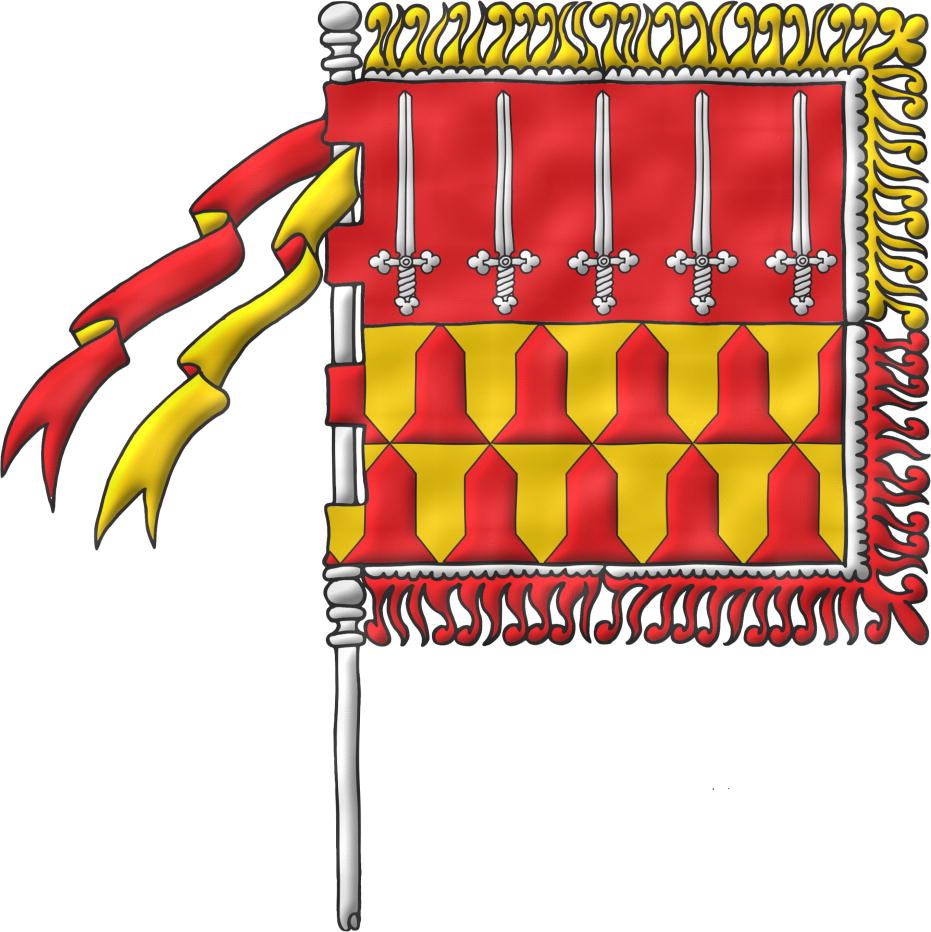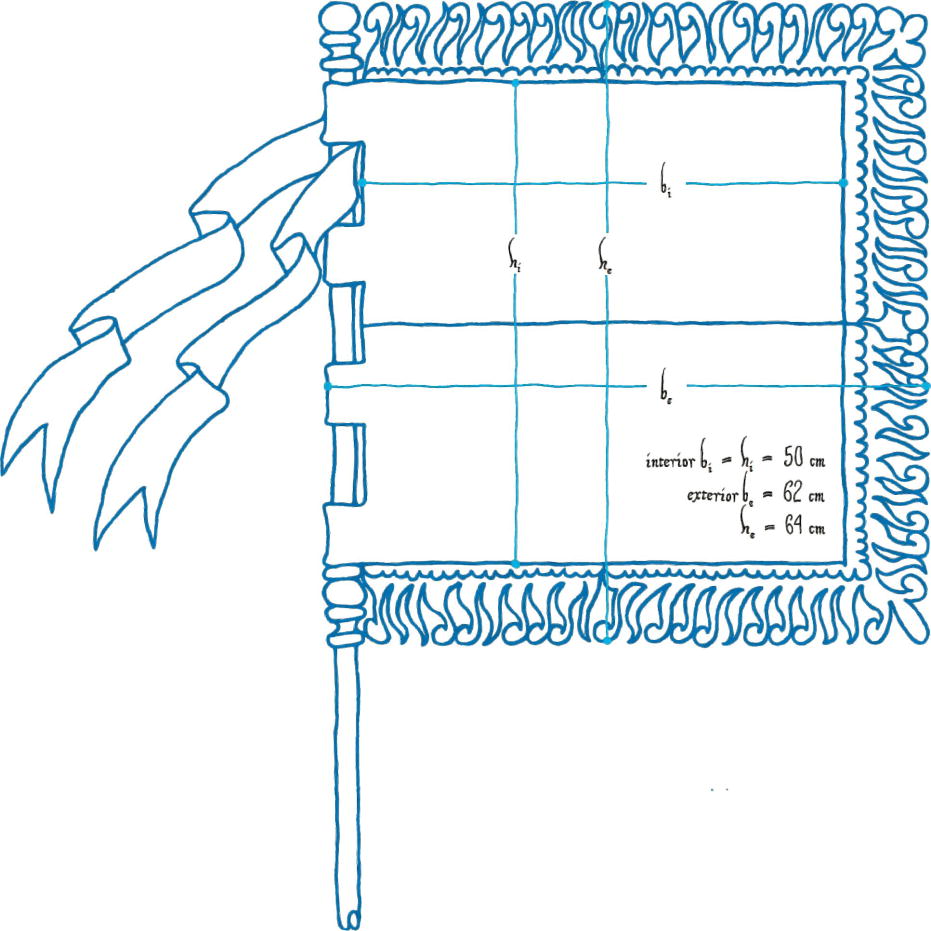
Martos García, Juan Carlos
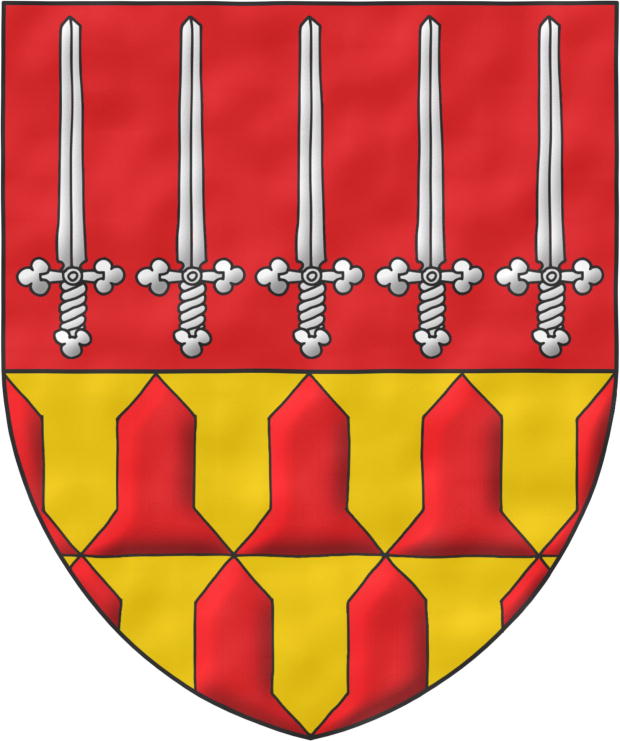
Party per fess: 1 Gules, five swords erect, in fess Argent; 2 Vairy Or and Gules.
Escudo cortado: 1o de gules, cinco espadas alzadas, en faja de plata; 2o verado de oro y gules.
Coat of arms that I have created with: a pointed base of the shield; the first field enamelled with flat Gules ink; the second field enamelled with flat Or ink; the swords and the vairy are illuminated; and the whole has received a watercolor finish.
Symbolism
There are 6 swords erect to defend the vairy of truth and, no matter how much time passes, they will not relent until the truth prevails.
Blazon keywords: Party per fess, Gules, Or, Argent, Five, Sword, Vairy, Point upwards and In fess.
Style keywords: Pointed, Illuminated, Outlined in sable and Watercolor.
Classification: Created, Personal and Coat of arms.
Bearer: Martos García, Juan Carlos.


Martos García, J. C., a supporter
Party per fess: 1 Gules, five swords erect, in fess Argent; 2 Vairy Or and Gules.
Escudo cortado: 1o de gules, cinco espadas de plata, alzadas, en faja; 2o verado de oro y gules. Soporte: Un león de oro, rampante, armado, lampasado, fierezado y encendido de gules a la siniestra.
Supporter and shield inclined to dexter with: a pointed base of the shield; its two fields enamelled with flat inks, Gules and Or respectively; the rest of the elements illuminated; everything outlined in Sable; and the whole executed with a raised-stroke technique.
Blazon keywords: Party per fess, Gules, Or, Argent, Five, Sword, Point upwards, In fess, Vairy, Lion, Rampant, Armed, Langued, The fangs, The eyes, Supporter (animal) and Supporter.
Style keywords: Pointed, Illuminated, Outlined in sable and Freehand.
Classification: Created, Personal and Coat of arms.
Bearer: Martos García, Juan Carlos.


Martos García, J. C., crest
Party per fess: 1 Gules, five swords erect, in fess Argent; 2 Vairy Or and Gules. Crest: Upon a helm with a wreath Or and Gules, a lion rampant Or, armed, langued, the fangs and the eyes Gules, grasping in its sinister paw a key Argent. Mantling: Gules doubled Or. Motto: «Veritas filia temporis» Gules over a scroll Argent.
Escudo cortado: 1o de gules, cinco espadas alzadas, en faja de plata; 2o verado de oro y gules. Timbrado de un yelmo, adornado de dos lambrequines de gules doblados de oro, un burelete de oro y gules, cimado de un león rampante de oro, armado, lampasado, fierezado y encendido de gules, teniendo en la siniestra una llave de plata. Lema: «Veritas filia temporis» de gules sobre una filacteria de plata.
Coat of arms with its crest made as follows: a pointed base; its two fields enamelled with flat inks, Gules and Or; the rest illuminated and outlined in Sable; the torse and mantling diapered with chinapiería; and the whole in raised-stroke.
Blazon keywords: Party per fess, Gules, Or, Argent, Five, Sword, Point upwards, In fess, Vairy, Crest and mantling, Helm, Mantling, Wreath, Crest, Lion, Rampant, Armed, Langued, The fangs, The eyes, Sinister, Grasping, Key and Motto.
Style keywords: Pointed, Illuminated, Outlined in sable and Freehand.
Classification: Created, Personal and Coat of arms.
Bearer: Martos García, Juan Carlos.


Martos García, J. C., crest and supporters
Party per fess: 1 Gules, five swords erect, in fess Argent; 2 Vairy Or and Gules. Crest: Upon a helm with a wreath Or and Gules, a lion rampant Or, armed, langued, the fangs and the eyes Gules, grasping in its sinister paw a key Argent. Mantling: Gules doubled Or. Supporters: Two lions rampant Or, armed, langued, the fangs and the eyes Gules. Motto: «Veritas filia temporis» Gules over a scroll Argent.
Escudo cortado: 1o de gules, cinco espadas alzadas, en faja de plata; 2o verado de oro y gules. Timbrado de un yelmo, adornado de dos lambrequines de gules doblados de oro, un burelete de oro y gules, cimado de un león rampante de oro, armado, lampasado, fierezado y encendido de gules, teniendo en la siniestra una llave de plata. Soportes: dos leones rampantes de oro, armados, lampasados, fierezados y encendidos de gules. Lema: «Veritas filia temporis» de gules sobre una filacteria de plata.
Arms and ornament created by me as follows: the base of the coat of arms is pointed; its fields have been enamelled with flat inks, Gules and Or; the rest of the elements are illuminated; everything is outlined in Sable; the mantling and the torse have been diapered with chinapiería; and the whole has received a watercolor finish.
This diapered known as «chinapiería» on the torse and on the mantling are registered as automatic painting in [Salmerón Cabañas, A.; 2008] y como marca registrada en [Salmerón Cabañas, A.; 2009].
Blazon keywords: Party per fess, Gules, Or, Argent, Five, Sword, Point upwards, In fess, Vairy, Crest and mantling, Helm, Mantling, Wreath, Crest, Lion, Rampant, Armed, Langued, The fangs, The eyes, Sinister, Grasping, Key, Supporter (animal), Supporter and Motto.
Style keywords: Pointed, Illuminated and Outlined in sable.
Classification: Created, Personal and Coat of arms.
Bearer: Martos García, Juan Carlos.


Martos García, J. C., video of the blazon
This video visualizes the blazon of this coat of arms step by step, from the creation of its fields to the placement of its supporters and motto. The typeface used in this video belongs to Dr. Marianne Steinbauer and the soundtrack to Kevin MacLeod.
Credits:
- Kevin MacLeod es el autor de la música.
- Dr.ª Marianne Steinbauer tiene los derechos del tipo de letra.
Blazon keywords: Party per fess, Gules, Or, Argent, Five, Sword, Point upwards, In fess, Vairy, Crest and mantling, Helm, Mantling, Wreath, Crest, Lion, Rampant, Armed, Langued, The fangs, The eyes, Sinister, Grasping, Key, Supporter (animal), Supporter and Motto.
Style keywords: Pointed, Illuminated, Outlined in sable and Watercolor.
Classification: Video, Created, Personal and Coat of arms.
Bearer: Martos García, Juan Carlos.


Juan Carlos Martos García
Silver-cord flag, fringed Or and Gules, charged with the same arms as the shield and flown on a pike.
This flag is part of the set of heraldic objects created for its holder which, as a whole, are:
- A coat of arms with 2 versions and several finishes: watercolor finish, raised-stroke, and repoussé metal.
- The coat of arms crested with helm, mantling, torse, and crest and with a motto.
- Two versions of the coat of arms, with one lion or with two lions rampant as supporters, and this latter version also with crest.
- A seal and an ex libris.
- A vairy border Or and Gules to frame paper and documents.
- The coat of arms with motto, crest, and two supporters mounted on a «Chinapiería», [Salmerón Cabañas, A.; 2009], in Argent and Or.
- This silver-cord flag.
Blazon keywords: Gules, Or, Argent, Five, Sword, Vairy, Point upwards and In fess.
Style keywords: Square, Illuminated, Outlined in sable and Watercolor.
Classification: Created, Personal and Flag.
Bearer: Martos García, Juan Carlos.


Diagram of a square flag
Inner dimensions 50 x 50 cm and outer dimensions 62 x 64 cm.
Classification: Schema and Flag.
Bearer: Martos García, Juan Carlos.


Martos García, Juan Carlos, seal
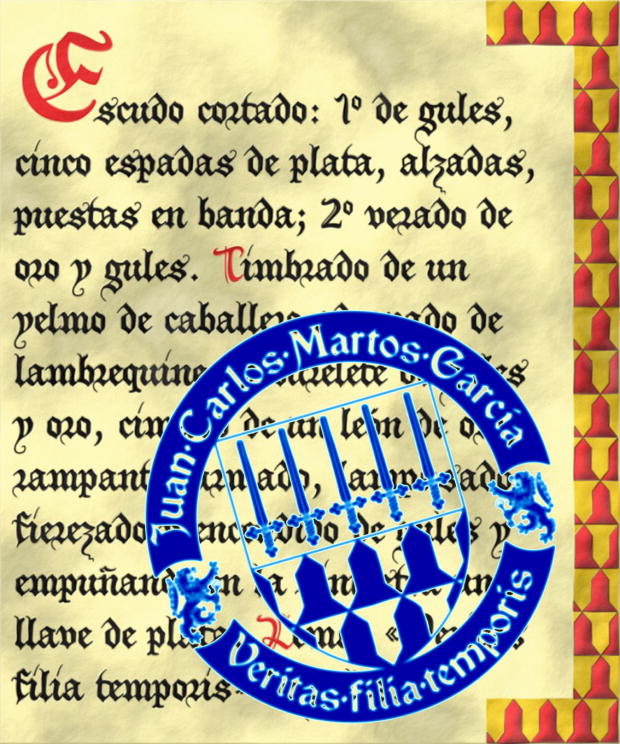
Seal created with the gentilic coat of arms in a pointed shape. The seal is supported by two lions rampant and surrounded, in its upper part, above the lions, by the full name of the holder of the gentilic coat of arms and, in its lower part, below the lions, by the holder's motto «Veritas filia temporis». In the side image, heraldically to sinister, the result of stamping this seal with Azure ink on a parchment. The parchment is decorated with a frame formed by a vairy Or and Gules and bearing the blazon of the coat of arms.
Blazon keywords: Azure, Motto, Motto (identification), Five, Sword, Vairy, Point upwards, In fess, Supporter (animal), Supporter, Lion and Rampant.
Style keywords: Round, Sealed and Plain tincture.
Classification: Created, Personal and Seal.
Bearer: Martos García, Juan Carlos.

Continue with: Martos García, Juan Carlos, ex libris.
-
Language
-
Categories of heraldry
-
Divisions of the field
- Without divisions
- Party per pale
- Party per fess
- Party per bend
- Party per bend sinister
- Tierce
- Tierce sinister
- Tierced per pale
- Tierced per fess
- Tierced per bend
- Tierced pallwise inverted
- Quarterly
- Quarterly per saltire
- Gyronny
- Party per fess, the chief per pale
- Party per pale, the sinister per fess
- Party per fess, the base per pale
- Party per pale, the dexter per fess
- Chapé
- Chaussé
- Embrassé
- Contre-embrassé
- Party per chevron
- Enté
- Enté en point
- Flanched
-
Metals
-
Colours
-
Furs
-
Other tinctures
-
Ordinaries and sub-ordinaries
-
Diminutives of the ordinaries
-
Geometric charges
-
Composite ordinaries
-
Inanimate charges from Nature
Atom, Crescent, Diamond, Emerald, Estoile, Increscent, Lightning flash, Moon, Mount, Mullet, Mullet of four points, Orbital, Plough of Ursa Major, Rainbow, Ray of the sun, River, Sea, Snowflake, Sun, Sun in splendour, Sun of May, Trimount, Water and Wave.
-
Vegetal charges from Nature
Acorn, Apple, Apple tree, Ash, Bluebonnet, Camellia, Chrysanthemum, Cinquefoil, Cornflower, Dogwood flower, Double rose, Elm, Fleur de lis, Flower, Gourd, Holm oak, Hop cone, Kapok tree, Laurel, Lily, Linden, Lotus flower, Madonna lily, Mexican cedar tree, Oak, Olive tree, Palm tree, Plantain plant, Pomegranate, Poplar leaf, Rose, Shamrock, Sunflower, Thistle, Tree, Tulip, Vine and Wheat.
-
Animal charges from Nature
Badger, Bald eagle, Barbel, Barn owl, Bear, Beaver, Beetle, Bighorn sheep, Blackbird, Boar, Brach hound, Bull, Doe, Dog, Dolphin, Dove, Eagle, Elephant, Falcon, Female figure, Fish, Flame, Fly, Fox, Frog, Goat, Goldfinch, Goose, Heron, Horse, Hummingbird, Jaguar, Lark, Leopard, Lion, Lion passant, Lion rampant guardant, Lioness, Lynx, Male figure, Martlet, Merino ram, Owl, Panther, Parrot, Peacock, Pelican, Pelican in her piety, Puffin, Quetzal, Raven, Roe deer, Rooster, Savage, Seagull, Serpent, She-wolf, Stag, Starling, Talbot, Tyger, Vulture, Warren hound and Wolf.
-
Parts of natural charges
Arm, Beak, Branch, Caboshed, Chest, Claw, Covert, Dorsal fin, Eagle claw, Ermine spot, Escallop, Feather, Foot (palmiped), Foreleg, Forepaw, Hand, Head, Heart, Hoof, Leaf, Neck, Ostrich feather, Palm frond, Paw, Roe deers' attires, Shoulder, Sprig, Stags' attires, Stem, Swallow-tail, Tail, Tail addorsed, Tail fin, Talon, Tooth, Trunk, Trunk (elephant), Two hands clasped, Two wings in vol, Udder, Wheat spike, Wing and Wrist.
-
Artificial charges
Ace of spades, Anchor, Anvil, Arch, Arm vambraced, Armillary sphere, Arrow, Axe, Bell, Bell tower, Beret, Bonfire, Book, Bookmark, Bow, Branding iron, Bridge, Broken, Buckle, Cannon, Cannon dismounted, Cannon port, Canopy roof, Carbuncle, Castle, Celtic Trinity knot, Chain, Chess rooks, Church, Clarion, Clay pot, Closed book, Club, Column, Comb, Compass rose, Conductor's baton, Cord, Covered cup, Crozier, Crucible, Cuffed, Cup, Cyclamor, Dagger, Double vajra, Drum, Ecclesiastical cap, Fanon, Federschwert, Fleam, Four crescents joined millsailwise, Galician granary, Garb, Gauntlet, Geometric solid, Grenade, Halberd, Hammer, Harp, Host, Hourglass, Key, Key ward, Knight, Knot, Lantern, Letter, Line, Loincloth, Menorah, Millrind, Millstone, Millwheel, Monstrance, Mortar, Mullet of six points pierced, Nail, Non-classic artifact, Norman ship, Number, Oar, Oil lamp, Open book, Page, Pair of scales, Parchment, Pestle, Piano, Pilgrim's staff, Plough share, Polish winged hussar, Port, Portcullis, Potent, Quill, Ribbon, Rosette of acanthus leaves, Sabre, Sackbut, Sail, Scroll, Scythe, Sheaf of tobacco, Ship, Skirt, Spear, Spear's head, Stairway, Star of David, Step, Sword, Symbol, Tetrahedron, Torch, Tower, Trident, Trumpet, Turret, Two-handed sword, Wagon-wheel, Water-bouget, Wheel, Winnowing fan and With a turret.
-
Immaterial charges
Angel, Archangel, Basilisk, Dragon, Dragon's head, Garuda, Golden fleece, Griffin, Heart enflamed, Justice, Mermaid, Our Lady of Mercy, Ouroboros, Paschal lamb, Pegasus, Phoenix, Sacred Heart of Jesus, Saint George, Sea-griffin, Trinity, Triton, Unicorn, Winged hand and Wyvern.
-
External elements
-
Heraldic creations
-
References
-
Formats
-
Keywords on this page
Watercolor, Point upwards, Pointed, Armed, Azure, Flag, Wreath, Crest, Five, Round, Party per fess, Created, Square, Outlined in sable, Motto (identification), In fess, The eyes, Coat of arms, Sword, Schema, Sealed, The fangs, Personal, Gules, Illuminated, Mantling, Langued, Motto, Lion, Key, Martos García, Juan Carlos, Or, Argent, Rampant, Seal, Sinister, Supporter (animal), Supporter, Grasping, Crest and mantling, Plain tincture, Freehand, Vairy, Video and Helm.

